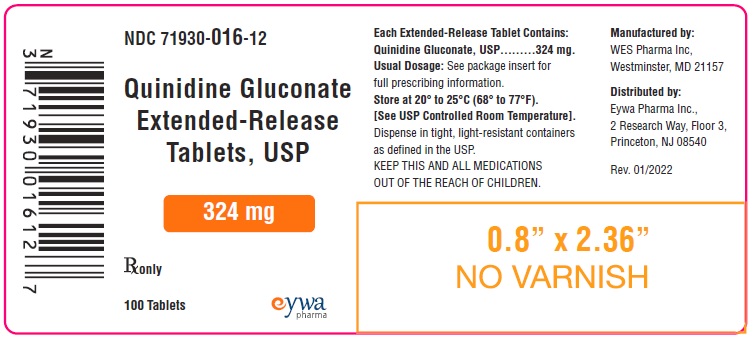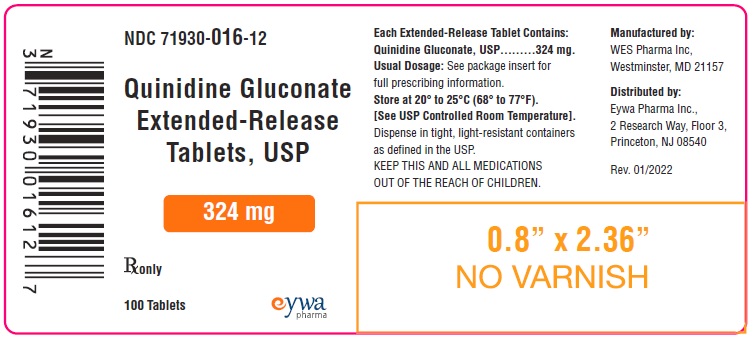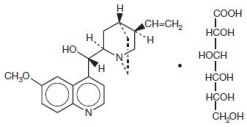Heart block
-
In patients without implanted pacemakers who are at high risk of complete atrioventricular block (e.g., those with digitalis intoxication, second degree atrioventricular block, or ...
Heart block
In patients without implanted pacemakers who are at high risk of complete atrioventricular block (e.g., those with digitalis intoxication, second degree atrioventricular block, or severe intraventricular conduction defects), quinidine should be used only with caution.
Thrombocytopenia
Quinidine should be discontinued in case of any signs or symptoms of thrombocytopenia (see WARNINGS).
Drug and Diet Interactions
Altered pharmacokinetics of quinidine: Diltiazem significantly decreases the clearance and increases the t1/2 of quinidine, but quinidine does not alter the kinetics of diltiazem.
Drugs that alkalinize the urine (carbonic-anhydrase inhibitors, sodium bicarbonate, thiazide diuretics) reduce renal elimination of quinidine.
By pharmacokinetic mechanisms that are not well understood, quinidine levels are increased by coadministration of amiodarone or cimetidine. Very rarely, and again by mechanisms not understood, quinidine levels are decreased by coadministration of nifedipine.
Hepatic elimination of quinidine may be accelerated by coadministration of drugs (phenobarbital, phenytoin, rifampin) that induce production of cytochrome P450IIIA4.
Perhaps because of competition for the P450IIIA4 metabolic pathway, quinidine levels rise when ketoconazole is coadministered.
Coadministration of propranolol usually does not affect quinidine pharmacokinetics, but in some studies the β-blocker appeared to cause increases in the peak serum levels of quinidine, decreases in quinidine's volume of distribution, and decreases in total quinidine clearance. The effects (if any) of coadministration of other β-blockers on quinidine pharmacokinetics have not been adequately studied.
Hepatic clearance of quinidine is significantly reduced during coadministration of verapamil, with corresponding increases in serum levels and half-life.
Grapefruit juice: Grapefruit juice inhibits P450 3A4-mediated metabolism of quinidine to 3-hydroxyquinidine. Although the clinical significance of this interaction is unknown, grape fruit juice should be avoided.
Dietary salt: The rate and extent of quinidine absorption may be affected by changes in dietary salt intake; a decrease in dietary salt intake may lead to an increase in plasma quinidine concentrations.
Altered pharmacokinetics of other drugs: Quinidine slows the elimination of digoxin and simultaneously reduces digoxin's apparent volume of distribution. As a result, serum digoxin levels may be as much as doubled. When quinidine and digoxin are coadministered, digoxin doses usually need to be reduced. Serum levels of digitoxin are also raised when quinidine is coadministered, although the effect appears to be smaller.
By a mechanism that is not understood, quinidine potentiates the anticoagulatory action of warfarin, and the anticoagulant dosage may need to be reduced.
Cytochrome P450IID6 is an enzyme critical to the metabolism of many drugs, notably including mexiletine, some phenothiazines, and most polycyclic antidepressants. Constitutional deficiency of cytochrome P450IID6 is found in less than 1% of Orientals, in about 2% of American blacks, and in about 8% of American whites. Testing with debrisoquine is sometimes used to distinguish theP450IID6-deficient "poor metabolizers" from the majority-phenotype "extensive metabolizers".
When drugs whose metabolism is P450IID6-dependent are given to poor metabolizers, the serum levels achieved are higher, sometimes much higher, than the serum levels achieved when identical doses are given to extensive metabolizers. To obtain similar clinical benefit without toxicity, doses given to poor metabolizers may need to be greatly reduced. In the case of prodrugs whose actions are actually mediated by P450IID6-produced metabolites (for example, codeine and hydrocodone, whose analgesic and antitussive effects appear to be mediated by morphine and hydromorphone, respectively), it may not be possible to achieve the desired clinical benefits in poor metabolizers.
Quinidine is not metabolized by cytochrome P450IID6, but therapeutic serum levels of quinidine inhibit the action of cytochrome P450IID6, effectively converting extensive metabolizers into poor metabolizers. Caution must be exercised whenever quinidine is prescribed together with drugs metabolized by cytochrome P450IID6. Perhaps by competing for pathways of renal clearance, coadministration of quinidine causes an increase in serum levels of procainamide.
Serum levels of haloperidol are increased when quinidine is coadministered.
Presumably because both drugs are metabolized by cytochrome P450IIIA4, coadministration of quinidine causes variable slowing of the metabolism of nifedipine. Interactions with other dihydropyridine calcium channel blockers have not been reported, but these agents (including felodipine, nicardipine, and nimodipine) are all dependent upon P450IIIA4 for metabolism, so similar interactions with quinidine should be anticipated.
Altered pharmacodynamics of other drugs: Quinidine's anticholinergic, vasodilating, and negative inotropic actions may be additive to those of other drugs with these effects, and antagonistic to those of drugs with cholinergic, vasoconstricting, and positive inotropic effects. For example, when quinidine and verapamil are coadministered in doses that are each well tolerated as monotherapy, hypotension attributable to additive peripheral α-blockade is sometimes reported.
Quinidine potentiates the actions of depolarizing (succinylcholine, decamethonium) and non-depolarizing (d-tubocurarine, pancuronium) neuromuscular blocking agents. These phenomena are not well understood, but they are observed in animal models as well as in humans. In addition, in vitro addition of quinidine to the serum of pregnant women reduces the activity of pseudocholinesterase, an enzyme that is essential to the metabolism of succinylcholine.
Non-interactions of quinidine with other drugs: Quinidine has no clinically significant effect on the pharmacokinetics of diltiazem, flecainide, mephenytoin, metoprolol, propafenone, propranolol, quinine, timolol, or tocainide.
Conversely, the pharmacokinetics of quinidine are not significantly affected by caffeine, ciprofloxacin, digoxin, felodipine, omeprazole, or quinine. Quinidine's pharmacokinetics are also unaffected by cigarette smoking.
INFORMATION FOR PATIENTS
Before prescribing quinidine gluconate as prophylaxis against recurrence of atrial fibrillation, the physician should inform the patient of the risks and benefits to be expected (see CLINICAL PHARMACOLOGY). Discussion should include the facts:
- that the goal of therapy will be a reduction (probably not to zero) in the frequency of episodes of atrial fibrillation; and
- that reduced frequency of fibrillatory episodes may be expected, if achieved, to bring symptomatic benefit; but
- that no data are available to show that reduced frequency of fibrillatory episodes will reduce the risks of irreversible harm through stroke or death; and in fact
- that such data as are available suggest that treatment with quinidine gluconate is likely to increase the patient's risk of death.
Carcinogenesis, mutagenesis, impairment of fertility
Animal studies to evaluate quinidine's carcinogenic or mutagenic potential have not been performed. Similarly, there are no animal data as to quinidine's potential to impair fertility.
Pregnancy
Animal reproductive studies have not been conducted with quinidine. There are no adequate and well-controlled studies in pregnant women. Quinidine should be given to a pregnant woman only if clearly needed.
In one neonate whose mother had received quinidine throughout her pregnancy, the serum level of quinidine was equal to that of the mother, with no apparent ill effect. The level of quinidine in amniotic fluid was about three times higher than that found in serum.
Labor and Delivery
Quinine is said to be oxytocic in humans, but there are no adequate data as to quinidine's effects (if any) on human labor and delivery.
Nursing mothers
Quinidine is present in human milk at levels slightly lower than those in maternal serum; a human infant ingesting such milk should (scaling directly by weight) be expected to develop serum quinidine levels at least an order of magnitude lower than those of the mother. On the other hand, the pharmacokinetics and pharmacodynamics of quinidine in human infants have not been adequately studied, and neonates' reduced protein binding of quinidine may increase their risk of toxicity at low total serum levels. Administration of quinidine should (if possible) be avoided in lactating women who continue to nurse.
Geriatric use
Safety and efficacy of quinidine in elderly patients have not been systematically studied.
Pediatric use
In antimalarial trials, quinidine was as safe and effective in pediatric patients as in adults. Notwithstanding the known pharmacokinetic differences between children and adults (see Pharmacokinetics and Metabolism), children in these trials received the same doses (on a mg/kg basis) as adults.
Safety and effectiveness of antiarrhythmic use in children have not been established.
Close



